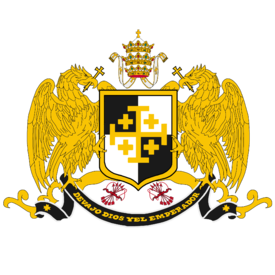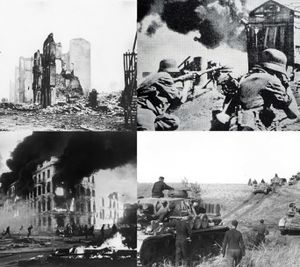Difference between revisions of "Portal:Creeperopolis"
m (Text replacement - "Creeperian Colón" to "Creeperian colón") |
m (Text replacement - "Creeperian Spanish" to "Creeperian") |
||
| Line 16: | Line 16: | ||
[[File:Coat of Arms of Creeperopolis.png|275px|thumb|right|border|[[Coat of arms of Creeperopolis]].]] | [[File:Coat of Arms of Creeperopolis.png|275px|thumb|right|border|[[Coat of arms of Creeperopolis]].]] | ||
| − | '''Creeperopolis''' ([[ | + | '''Creeperopolis''' ([[Creeperian language|Creeperian]] – [[Creeperian script|Creeperian]]: ''Ծրեեպերօպոլիս''; Creeperian Spanish – [[Iberic script|Iberic]]: ''Creeperópolis''; <small>Creeperian Spanish pronunciation:</small> {{color|#122080|[kri.peɾˈo.po.lis]}}), officially the '''Holy Traditionalist Empire of Creeperopolis''' (Creeperian: ''Սանտո Իմպերիո Տրադիծիոնալիստա դե Ծրեեպերօպոլիս''; Iberic: ''Santo Imperio Tradicionalista de Creeperópolis''), is the largest nation in [[Sur]] and the 4th largest in the world by land area. Creeperopolis is bordered to the north by the [[Montcrabe|Directorial Republic of Montcrabe]], to the south by the [[Sequoyah|Republic of Sequoyah]] and the [[Senvarian Sea]], to the west by the [[Sea of Castilliano]], the [[Salisford|Kingdom of Salisford]], and the [[El Salvador|Principality of El Salvador]], and to the east by the [[Bay of Salvador]] and the [[Southern Ocean]]. Creeperopolis completely enclaves the client state and religious nation, artificially established by Creeperopolis, known officially as the [[State of the Church|State of the Church]]. Creeperopolis' capital and largest city is [[San Salvador, San Salvador|San Salvador]] located near the center of the country along the southern coast of [[Lake San Salvador]] and west of [[Lake Zapatista]]. As of 2020, Creeperopolis has a population of 532 million, making it the [[List of Countries by Population|most populous nation]] in the [[Portal:Terraconserva|world]]. |
Creeperopolis is the world's second largest economy at ₡94.4 trillion [[Creeperian colón|colóns]], second only to [[Quebecshire]]. The country continues to struggle with [[Economy of Creeperopolis|massive wealth inequality]], [[Crime in Creeperopolis|rampant crime and crime rates]], [[List of Ongoing Armed Conflicts|four ongoing internal armed conflicts]], [[Corruption in Creeperopolis|rampant government and corporate corruption]], and unprecedented [[Poverty in Creeperopolis|poverty rates of 20–25%]]. The official currency of Creeperopolis is the Creeperian colón and it has been since the relinquishment of the [[Creeperian Dollar]] following the 2003 Creeperian coup d'état. Creeperopolis has been commonly called terms such as a dictatorship, fascist, totalitarian, police state, and banana state, many of which have varying degrees of accuracy. | Creeperopolis is the world's second largest economy at ₡94.4 trillion [[Creeperian colón|colóns]], second only to [[Quebecshire]]. The country continues to struggle with [[Economy of Creeperopolis|massive wealth inequality]], [[Crime in Creeperopolis|rampant crime and crime rates]], [[List of Ongoing Armed Conflicts|four ongoing internal armed conflicts]], [[Corruption in Creeperopolis|rampant government and corporate corruption]], and unprecedented [[Poverty in Creeperopolis|poverty rates of 20–25%]]. The official currency of Creeperopolis is the Creeperian colón and it has been since the relinquishment of the [[Creeperian Dollar]] following the 2003 Creeperian coup d'état. Creeperopolis has been commonly called terms such as a dictatorship, fascist, totalitarian, police state, and banana state, many of which have varying degrees of accuracy. | ||
Revision as of 19:43, 12 March 2024
¡Hola! ¡Bienvenidos a Creeperópolis!
Creeperopolis (Creeperian – Creeperian: Ծրեեպերօպոլիս; Creeperian Spanish – Iberic: Creeperópolis; Creeperian Spanish pronunciation: [kri.peɾˈo.po.lis]), officially the Holy Traditionalist Empire of Creeperopolis (Creeperian: Սանտո Իմպերիո Տրադիծիոնալիստա դե Ծրեեպերօպոլիս; Iberic: Santo Imperio Tradicionalista de Creeperópolis), is the largest nation in Sur and the 4th largest in the world by land area. Creeperopolis is bordered to the north by the Directorial Republic of Montcrabe, to the south by the Republic of Sequoyah and the Senvarian Sea, to the west by the Sea of Castilliano, the Kingdom of Salisford, and the Principality of El Salvador, and to the east by the Bay of Salvador and the Southern Ocean. Creeperopolis completely enclaves the client state and religious nation, artificially established by Creeperopolis, known officially as the State of the Church. Creeperopolis' capital and largest city is San Salvador located near the center of the country along the southern coast of Lake San Salvador and west of Lake Zapatista. As of 2020, Creeperopolis has a population of 532 million, making it the most populous nation in the world.
Creeperopolis is the world's second largest economy at ₡94.4 trillion colóns, second only to Quebecshire. The country continues to struggle with massive wealth inequality, rampant crime and crime rates, four ongoing internal armed conflicts, rampant government and corporate corruption, and unprecedented poverty rates of 20–25%. The official currency of Creeperopolis is the Creeperian colón and it has been since the relinquishment of the Creeperian Dollar following the 2003 Creeperian coup d'état. Creeperopolis has been commonly called terms such as a dictatorship, fascist, totalitarian, police state, and banana state, many of which have varying degrees of accuracy.
Noundures (Salvadoran pronunciation: [nownˈdu.ɾɛs]), officially the Free Republic of Noundures (Salvadoran: República Lliure de Noundures), and formerly known as the State of Noundures (Estat de Noundures), is a semi-recognized breakaway state located in Sur whose territory is internationally recognized as a part of Salisford. The state is landlocked and located in the northern Salvadoran Valley, being bordered by Salisford in the north and El Salvador in the south. El Salvador is the only nation to formally recognize Noundures; Creeperopolis formerly recognized the breakaway state from 1961 until the signing of the Rubicon Agreement in 1976.
On 10 July 1933, the State of Granada invaded the Modica Strip on its northern border, beginning the Desert War. The Granadian government proclaimed the establishment of the State of Noundures as a breakaway state in the Modica Strip with the intention of eventually unifying the two states together. After the fall of the Granadian government in 1935 and the overthrow of President Adalbert Boronat Cruilles, however, all plans to unify El Salvador and Noundures were abandoned, and Noundures lost all support from the new Salvadoran government due to its previous support by the Granadians. In 1944, Noundurian President Llorenç Bataller Zúrich unified the four rebel groups fighting against the Salisfordian government into the Free Noundurian Army (ENL). Read more...- Mayor of Chalatenango, Schafik Handal López (pictured) was arrested by the National Intelligence Directorate on charges of financially supporting the Deltinian Liberation Army.
- Professor Orlando Pareja Palau of Antonio José Sáenz Heredia University gave a lecture attacking and antagonized the government of Sequoyah, comparing it to Morova.
- The Deltinian Liberation Army accused the 25th Creeperian Army of indiscriminately killing Deltinian civilians. The DLA provided photos but the Ministry of Internal Affairs stated that the photos were clearly photoshopped and some were even photos of dead Creeperian civilians killed by the DLA.
- Hundreds Neo-Saelicists marched in the streets of Sonsonate celebrating the legacy of Castillianan dictator and caudillo Maximiliano Saelices Dávalos who ruled Castilliano from 1823 until 1845. After the march, 5 protestors were arrested on charges of assault while 14 Neo-Saelicists were arrested on charges of assault and conspiracy.
- The United Self-Defense Forces of Creeperopolis captured the Mara Salvatrucha controlled city of Colobador with little opposition.

Minister of Defense Adolfo Cabañeras Moreno reading orders to his officers during the Papal War, 1938.
- ...that Creeperopolis is one of the most densely populated countries in Terraconserva and on the Southern Landmass?
- ...that Creeperopolis uses the Colón as its currency?
- ...that Creeperopolis is currently embroiled in ongoing internal conflicts?
- ...that Creeperopolis is known worldwide for its high quality coffee and sugar?
- ...that Creeperopolis is actively exterminating mosquitos?
- ...that Creeperopolis used to be a republic from 1729-1730?
- ...that Creeperopolis is one of two nations with Spanish as a dominant language?
- ...that Creeperopolis currently constitutes the death penalty for abortion?
The Siege of San Salvador (Creeperian – Creeperian: Սիտո ել Սան Սալվադոր; Creeperian – Iberic: Sito de San Salvador), also referred to as the Battle of San Salvador (Բատաժա ել Սան Սալվադոր; Batalla de San Salvador), and known in modern-Creeperopolis as The Siege (Ել Սիտո; El Sito), was the largest and deadliest confrontation of the Creeperian Civil War between the Catholic Imperial Restoration Council (Imperial Council) and the National Council for Peace and Order (National Council). The battle was fought mostly within the department of San Salvador, one of the most strategically and symbolically important regions of the country. Due to its large and complicated nature, the siege has sometimes been considered to be its own war within the Creeperian Civil War.
The siege began in May 1946 with an initial attack by the National Council against forces of the Imperial Council. The National Council's failure to win a quick and decisive victory over the Imperial Council led to a stalemate and long-lasting siege, as neither side was able to break through the other's defenses. A final offensive by the Imperial Council in August 1949 forced a National Council retreat, ending the siege in a decisive Imperial Council victory. The civil war itself would later end on 30 September 1949. Read more...











